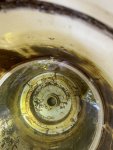If you check the total head at the speed curve, the numbers don't exactly match up.
For example, at 3,450 rpm, the total head is measured at about 69 feet. The flow at 69 feet of head should be about 120 gpm at 3,450 rpm.
The measured flow is 62 gpm, which is significantly less than expected. For 62 gpm, the head loss from the curve is about 91 feet vs. the measured head loss at 69 feet.
For 3,110 rpm, you're getting 67 feet and 60 gpm. 67 feet would be about 75 gpm.
60 gpm would be about 73 feet of head.
For 2,350 rpm, you're getting 40 feet and 40 gpm. For 40 feet of head, the flow would be about 55 gpm. For 40 gpm, the head loss would be about 42 feet.
At lower speed, the numbers are not too far off.
At full speed, the pump is possibly cavitating.
Definitely keep the flow below 40 gpm unless you get the plumbing improved.
How much flow does the solar need?



